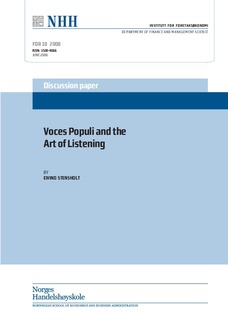| dc.contributor.author | Stensholt, Eivind | |
| dc.date.accessioned | 2008-06-24T13:06:13Z | |
| dc.date.available | 2008-06-24T13:06:13Z | |
| dc.date.issued | 2008-06 | |
| dc.identifier.issn | 1500-4066 | |
| dc.identifier.uri | http://hdl.handle.net/11250/163935 | |
| dc.description.abstract | The strategy most damaging to many preferential election methods is to give insincerely low rank to the main opponent of one’s favorite candidate. Theorem 1 determines the 3-candidate Condorcet method that minimizes the number of noncyclic profiles allowing this strategy. Theorems 2, 3, and 4 establish conditions for an anonymous and neutral 3-candidate single-seat election to be monotonic and still avoid this strategy completely. Plurality elections combine these properties; among the others "conditional IRV" gives the strongest challenge to the plurality winner. Conditional IRV is extended to any number of candidates. Theorem 5 is an impossibility of Gibbard-Satterthwaite type, describing 3 specific strategies that cannot all be avoided in meaningful anonymous and neutral elections. | en |
| dc.language.iso | eng | en |
| dc.publisher | Norwegian School of Economics and Business Administration. Department of Finance and Management Science | en |
| dc.relation.ispartofseries | Discussion paper | en |
| dc.relation.ispartofseries | 2008:10 | en |
| dc.title | Voces populi and the art of listening | en |
| dc.type | Working paper | en |
| dc.subject.nsi | VDP::Samfunnsvitenskap: 200::Statsvitenskap og organisasjonsteori: 240 | en |
